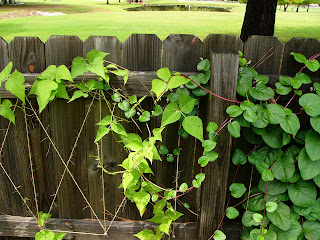So it's been raining gloriously all day, a day without having to water the garden (yes!), a day where the rain barrels get filled (YES!) (and remind me that I really need to get that 3rd barrel up), a day where I have to walk a stupid scared bitch (dog, really) in rain, amidst thunder and a leetle lightning and get my flip floppy toes ankle deep in what I am sure is chemical awashed puddles.
Man, suburbia. Land where all the lawns must be tidy and trimmed, green and lush, pumped up with fake goodness. I got a beef with pretty lawns, just like I got a beef with plastic surgery, it's faaaaaaaaaaake.
Unless you happen to use one of those lawn care services that states and you can attest to researching their practices that they are eco-friendly, most likely you are creating a desert like ecosystem with your lawn.
I don't know if it bothers you, like it bothers me, but those little yellow and white balls that go 'crunch-crunch' underneath your shoes/the dog's feet when you walk REALLY lose their charm especially as the PAVEMENT does not need any fertilization. It's all just going down the drain and polluting the water, y'know? I shudder to think as to what my dog must be picking up as she marches over those things or through the puddles and lush grass she does her biz in.
Lovely lawns also mean chemicals to kill weeds--- and grubs. No weeds, while less to deal with means fewer flowers for bees to survive on. As I overheard somewhere once, immaculate lawns look like deserts to bees, no flowers mean no food. Bad for survival, and aren't we lacking in bees already? (http://www.pbs.org/wnet/nature/episodes/silence-of-the-bees/introduction/38/)
Also, many of these same chemicals adversely affect the larva of lightning bugs! CAN YOU IMAGINE A WORLD WITHOUT LIGHTNING BUGS?
To quote what many a politician have invoked:
Think of the children!!! (!!!)
Ahem. Not only are lightning bugs helpful little critters in producing some lovely natural mood lighting (joke), and are entertaining reminders of youth, the larvae are predators of snails and slugs, the bane of many a gardener everywhere.
So, if you see a lil' guy like this:

And you start to raise your hand, HEAR MY VOICE IN YOUR HEAD, "DO NOT SQUISH!"
Here's a helpful site about the buggers:
http://aggie-horticulture.tamu.edu/Galveston/beneficials/beneficial-40_lightning_bug.htm
So, despite my husband and I letting the lawn go to hell, I will NOT say that you must too. I provide (yes, I am a provider!) some helpful links and a helpful summary as to how to keep you lawn in good organic condition DESPITE being a vegetable gardener and not caring in general a squirrel's behind for lawns (and your mother smells like elderberry!)
SOME ORGANIC LAWNCARE TIPS:
1) Weeds- don't like them? Hand pull! This is the most effective method of getting rid of weeds. You get some great some exercise (work them abs!) and learning about the deliciousness of dandelion wine, dandelion leaf greens, lambs quarters and more.
(Lambsquarters! Steam like spinach!)

If you REALLY don't want the exercise, you can spot treat specific weeds by using this concotion:
5 parts white vinegar, 2 parts water, 1 part dish soap (http://www.eartheasy.com/grow_lawn_care.htm), or some people reccomend straight vinegar or boiling water, choose your poison.
Further prevention of weeds can be done using corn gluten meal which can easily be bought in some feed stores to be used as a weed pre-emergent preventer. Sadly this is not CORNMEAL, the stuff that your mama makes her famous bread and stuffing with, but that stuff from the store can coincidently be used as an anti-fungicide, good for gardens and lawns too actually. The stats on cornmeal gluten are fascinating too (see prior eartheasy.com link)
Also, if you thought Roundup was a safe method, please reconsider:

Yeah, let's stop being a society of simple convenience. It's not always worth it.
2) Grubs- We all hate those Japanese beetles and their nasty grub babies, but an awesome way to prevent for a VERY LONG TIME their existence on your lawn (and from munching on your veggies) is milky spore. This is a natural bacterium that affects only Japanese beetles and after a few treatments is known to last for potentially decades in your soil speciding (word?) the critters for years!
When a grub is infected by the bacterium and dies in the soil, it's a gift that keeps on giving to the other grubs! It's SELF SUSTAINING, whoo!

3) Fertilization- As mentioned before, cornmeal is good, though a super easy method to refertilize your lawn is to leave the grass clippings on the lawn. Remarkable eh? No bagging needed! All that work the grass went into to get tall goes back into the lawn to replenish again, oh Nature, you are brilliant!
Clover is not the enemy. Please repeat that. It's nitrogen fixing, like beans and peas, and that means it self fertilizes and those around it. (It also makes a snazzy green manure for you vegetable gardeners out there).

(thanks to Bruce Lynn, lovely pic)
Those are a few tips, but obviously there is more to learn in the wide world of the internets.
Some interesting articles:
About the background of herbicides:
http://www.emagazine.com/view/?2476&printview&imagesoff
On fertilizers and Michael Pollan (author of "Omnivore's Dilemma" and "In Defense of Food"):
http://www.michaelpollan.com/press.php?id=49


 (Thanks OSU for pic)
(Thanks OSU for pic)








